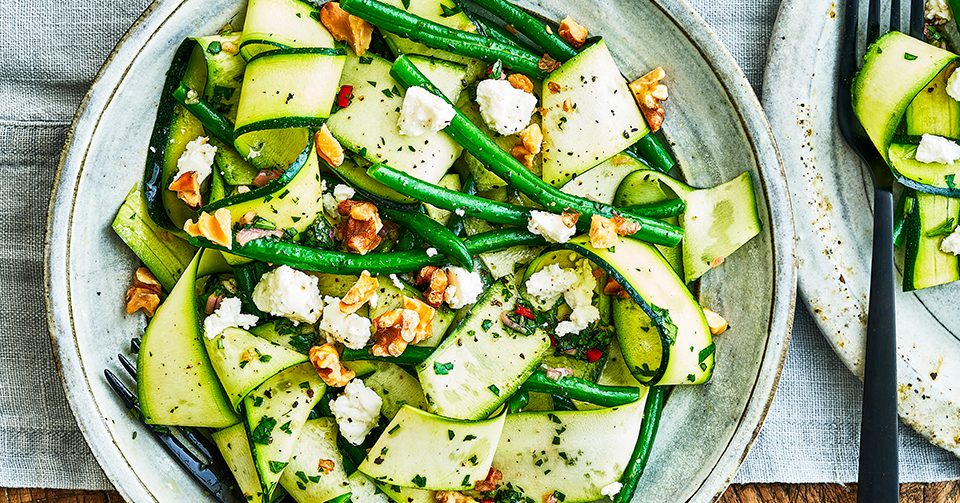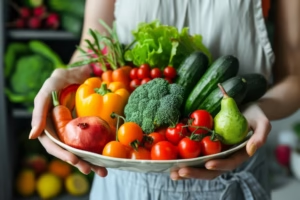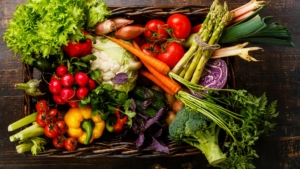Picture this: It’s a warm summer afternoon, and I’m standing in my kitchen, chopping crisp lettuce and vibrant cucumbers, the air filled with the fresh, earthy scent of greens. I remember the first time I tried making a green vegetable salad—it was a disaster! I tossed in every vegetable I could find, drowned it in dressing, and ended up with a soggy mess. But over the years, I’ve learned the art of crafting a green vegetable salad that’s not only healthy but also bursts with flavor and texture. In this guide, I’ll share everything you need to know to create your own perfect green vegetable salad, from choosing the freshest ingredients to mastering the dressing.
What Is a Green Vegetable Salad?
A green vegetable salad is a dish centered around leafy greens and other green vegetables, often combined with complementary ingredients like nuts, seeds, or dressings to enhance flavor. It’s a versatile, nutrient-packed meal or side dish that can be tailored to any taste or dietary need. Whether you’re a health enthusiast or just looking for a refreshing meal, green salads are a go-to option.
Why Are Green Vegetable Salads So Popular?
Green salads have surged in popularity due to their health benefits and adaptability. They’re low in calories, rich in vitamins, and can be customized for vegan, keto, or gluten-free diets. Plus, they’re quick to prepare, making them a favorite for busy folks craving something fresh.
Nutritional Benefits of Green Vegetables
Green vegetables like spinach, kale, and broccoli are powerhouse ingredients. They’re loaded with vitamins A, C, and K, plus fiber and antioxidants. These nutrients support everything from heart health to glowing skin, making green salads a smart choice for wellness.
Choosing the Best Greens for Your Salad
The foundation of any green vegetable salad is, of course, the greens. Not all greens are created equal, and picking the right ones can make or break your salad. I learned this the hard way when I once used only bitter greens and ended up with a salad that tasted like a lawn clipping!
Leafy Greens: The Backbone of Your Salad
Leafy greens provide the bulk of your salad’s volume and nutrients. Popular options include romaine, spinach, arugula, and kale. Each has a unique flavor—romaine is crisp, spinach is mild, arugula is peppery, and kale is hearty.
Comparison of Popular Leafy Greens
| Green | Flavor | Texture | Best Use |
|---|---|---|---|
| Romaine | Mild, slightly sweet | Crisp | Caesar salads, wraps |
| Spinach | Mild, slightly earthy | Soft | Smoothies, light salads |
| Arugula | Peppery, bold | Tender | Mixed green salads |
| Kale | Earthy, slightly bitter | Chewy | Massaged salads, hearty dishes |
Green Vegetables to Add Crunch and Color
Beyond leafy greens, other green vegetables add texture and visual appeal. Think cucumbers, zucchini, green beans, or snap peas. These veggies bring a satisfying crunch and pair well with creamy dressings or tangy vinaigrettes.
Where to Source Fresh Greens
For the freshest greens, visit local farmers’ markets or trusted grocers like Whole Foods or Sprouts. If you’re feeling adventurous, try growing your own lettuce or spinach—there’s nothing like harvesting your own salad ingredients! Websites like LocalHarvest can help you find nearby markets.
Building the Perfect Green Vegetable Salad
Creating a balanced salad is like painting a masterpiece—you need the right mix of colors, textures, and flavors. My go-to formula is greens, crunch, protein, and a killer dressing. Let’s break it down.
Step 1: Start with a Base of Greens
Choose one or two leafy greens as your base. I love mixing romaine and arugula for a balance of crisp and peppery. Aim for about 2 cups of greens per serving to keep it substantial but not overwhelming.
Step 2: Add Green Vegetables for Texture
Incorporate green veggies like sliced cucumbers, blanched broccoli, or raw zucchini ribbons. These add crunch and keep the salad monochromatic yet exciting. A mandoline slicer, like the OXO Good Grips Mandoline, makes quick work of slicing veggies evenly.
Step 3: Include a Protein Source
Protein makes your salad a meal. Options like grilled chicken, chickpeas, tofu, or hard-boiled eggs work well. For a vegan twist, I often toss in roasted chickpeas—they’re crunchy and packed with flavor.
Step 4: Add Nuts, Seeds, or Fruits
For extra texture, sprinkle in almonds, pumpkin seeds, or even green apple slices. These add a touch of sweetness or nuttiness that elevates the dish. Just don’t overdo it—a tablespoon or two is plenty.
Step 5: Dress It Up
The dressing ties everything together. A simple olive oil and lemon vinaigrette is my go-to, but creamy avocado or tahini dressings are also fantastic. Make your own to control the flavor and avoid excess sugar or preservatives.
Simple Vinaigrette Recipe
- Ingredients: ¼ cup olive oil, 2 tbsp lemon juice, 1 tsp Dijon mustard, 1 garlic clove (minced), salt, and pepper.
- Instructions: Whisk all ingredients until emulsified. Drizzle over salad and toss gently.
Pros and Cons of Green Vegetable Salads
Every dish has its strengths and weaknesses. Here’s a quick look at green vegetable salads to help you decide if they’re right for you.
Pros
- Nutrient-Dense: Packed with vitamins, minerals, and fiber.
- Versatile: Easily customized for any diet or preference.
- Quick to Prepare: Most salads take under 15 minutes to assemble.
- Budget-Friendly: Greens and veggies are often affordable, especially in season.
Cons
- Short Shelf Life: Fresh greens wilt quickly, so eat them soon after purchase.
- Dressing Pitfalls: Store-bought dressings can be high in calories or sodium.
- Time-Intensive Prep: Washing and chopping greens can be tedious without proper tools.
Tools and Equipment for Salad Success
You don’t need a fancy kitchen to make a great salad, but a few tools can make the process easier. Here’s what I recommend based on my own trial and error.
Best Tools for Preparing Green Salads
- Salad Spinner: Removes excess water from greens for crisp salads. The OXO Salad Spinner is a reliable choice.
- Mandoline Slicer: Creates uniform slices for veggies like cucumbers or zucchini.
- Mixing Bowls: Wide, shallow bowls make tossing salads easier.
- Mason Jars: Perfect for storing homemade dressings or prepping salads to-go.
Where to Buy Quality Salad Tools
You can find these tools at kitchen retailers like Williams Sonoma or online at Amazon. For budget options, check out Target or Walmart for affordable yet durable kitchenware.
People Also Ask (PAA) Section
Here are answers to common questions about green vegetable salads, sourced from Google’s PAA feature.
What are the healthiest greens for a salad?
Spinach, kale, and arugula top the list due to their high nutrient content. They’re rich in vitamins A, C, and K, plus antioxidants. Mix them for a balanced flavor and texture.
How do you keep a green salad fresh?
Store greens in an airtight container with a paper towel to absorb moisture. Keep dressings separate until serving to avoid sogginess. Eat within 2–3 days for maximum freshness.
Can you make a green salad ahead of time?
Yes, prep greens and veggies in advance and store them separately. Assemble and dress the salad just before eating to maintain crispness. Mason jar salads are great for meal prep.
What dressings go best with green salads?
Vinaigrettes like balsamic or lemon-based dressings complement green salads well. Creamy options like avocado or tahini dressings add richness without overpowering the greens.
Tips for Making Your Salad Stand Out
Want to take your green vegetable salad to the next level? Here are some tricks I’ve picked up over the years.
Experiment with Flavors
Try adding fresh herbs like basil or mint for a burst of flavor. A sprinkle of feta cheese or a handful of pomegranate seeds can also make your salad pop.
Play with Textures
Combine soft greens like spinach with crunchy veggies like snap peas. Toss in some toasted nuts or croutons for contrast. Texture is key to keeping things interesting.
Balance the Dressing
Too much dressing can drown your salad, while too little leaves it bland. Aim for about 1–2 tablespoons per serving and toss thoroughly to coat every leaf.
Green Vegetable Salad Recipe Ideas
Here are two of my favorite green vegetable salad recipes to inspire you. They’re simple, delicious, and perfect for any occasion.
Classic Green Crunch Salad
This salad is my go-to for weeknight dinners. It’s quick, fresh, and pairs well with any protein. The lemon vinaigrette keeps it light and zesty.
Ingredients
- 2 cups romaine lettuce, chopped
- 1 cup cucumber, sliced
- ½ cup green beans, blanched
- ¼ cup almonds, slivered
- Lemon vinaigrette (see recipe above)
Instructions
- Toss romaine, cucumber, and green beans in a large bowl.
- Drizzle with lemon vinaigrette and toss to coat.
- Top with slivered almonds and serve immediately.
Kale and Avocado Power Salad
This hearty salad is perfect for lunch. The creamy avocado dressing makes it feel indulgent, but it’s still packed with nutrients.
Ingredients
- 2 cups kale, destemmed and chopped
- 1 cup zucchini, spiralized
- ½ avocado, mashed
- 1 tbsp olive oil
- 1 tbsp lime juice
Instructions
- Massage kale with a pinch of salt to soften it.
- Add zucchini and toss gently.
- Mix avocado, olive oil, and lime juice for dressing. Drizzle over salad and serve.
FAQ Section
What’s the best way to wash greens for a salad?
Rinse greens under cold water, then use a salad spinner to remove excess moisture. This keeps them crisp and ready for dressing.
Are green vegetable salads good for weight loss?
Yes, they’re low in calories and high in fiber, which helps you feel full. Pair with lean proteins and light dressings for best results.
Can I use frozen green vegetables in a salad?
Frozen veggies are better for cooking, as they lose their crunch when thawed. Stick to fresh greens and veggies for salads.
How do I make a green salad more filling?
Add proteins like chickpeas, tofu, or grilled chicken. Nuts, seeds, or whole grains like quinoa can also make it more substantial.
Where can I find organic greens for salads?
Check local farmers’ markets, grocery stores like Whole Foods, or online retailers like Thrive Market for organic greens.
Final Thoughts
Crafting the perfect green vegetable salad is all about balance—flavors, textures, and nutrients working together to create something delicious and nourishing. Whether you’re tossing together a quick lunch or prepping a side dish for a family dinner, green salads offer endless possibilities. So grab some fresh greens, get creative, and enjoy the process. Your taste buds (and your body) will thank you!




